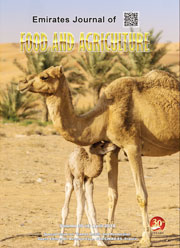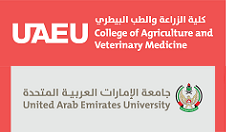FORAGE YIELD AND QUALITY POTENTIAL OF WINTER CEREAL-VETCH MIXTURES UNDER RAINFED CONDITIONS
DOI:
https://doi.org/10.9755/ejfa.v22i1.4904Keywords:
Cereal vetch mixture, fodder yield, quality, growth stages, rainfed conditions.Abstract
Livestock in rainfed area of Pothwar often faces green fodder scarcity during winter months and thus has to survive on cereal residues of previous crops such as wheat straw, summer sorghum, corn stalk etc. which are not rich source of protein and digestible nutrients. The basic objective of this experiment is to produce more fodder for livestock production and food for community. The investigations were carried out to evaluate the yield and quality of oat (Avena sativa L.), barely (Hordeum vulgare) and wheat (Triticum aestivum) in pure stands as well as in mixture of 50:50 ratios with common vetch (Vicia sativa L.) under rainfed conditions of Pothowar to address the problem of nutritious green fodder for livestock in the region. From the result of this study, it is evident that oatvetch mixture performed better under rainfed conditions of Pothowar in terms of green and dry matter yield. By this mixture, 37.97 tons ha-1 green and 9.28 ton ha-1 dry matter yield were obtained which are 20 % higher than the pure stand of oat respectively. Similarly, it was found that overall oat + vetch, mixture yielded 63% and 78% higher dry matter than barley + vetch and wheat-vetch mixtures, respectively. Cereal + vetch mixture also produced higher crude protein content than their respective pure stands. Oats-vetch, barley + vetch and wheat + vetch resulted in 11.31%, 7.04% and 5.80% higher crude protein contents than their cereal pure stands respectively. With the advancement of growth stage, green fodder yield increased progressively while reverse was observed for qualitative traits. Maximum green fodder yield was obtained at 50% heading stage while maximum crude protein content was achieved at tillering stage in this study. On the basis of these field qualitative and quantitative investigations, cereal + vetch mixture is recommended for both obtaining higher tonnage and nutritious fodder under the rainfed conditions of Pothowar.
Downloads
References
Fixation and excretion of nitrogen by
tropical legumes. Agron. J. 64: 409-
412.
Ahmad, G., M. Ansar, S. Kaleem, G. Nabi
and M. Hussain. 2008. Performance
of early maturing oats cultivars for
yield and quality. J. Agri. Res. 46(2):
341-346.
Al-Masri, M. R. 1998. Yield and nutritive
of vetch - barely forage under
different harvesting regimens. Trop.
Grasslands 32:201-206.
Alzueta, C., R. Caballero, A. Rebole, J.
Trevino and A. Gill. 2001. Crude
protein fraction in common vetch
fresh forage during pod filling. J.
Animal Sci. 79:2449-2455.
Anwar, A., M. Ansar, M. Nadeem, G.
Ahmad, S. Khan and A. Hussain.
2010. Performance of non traditional
winter legumes with oat for forage
yield and soil health under rainfed
conditions. J. Agri. Res. 48(1) (in
press).
Assefa, G. and I. Ledin. 2001. Effect of
variety, soil type, and fertilizer on the
establishment, growth, forage yield,
quality and voluntary intake by cattle
of oats and vetches cultivated in pure
stands and mixtures. Anim. Feed. Sci.
Tech. 92:95-111.
Caballero, R. and E. L. Goicoechea. 1986.
Utilization of winter cereals as
companion crops for common vetch
and hairy vetch. Proceedings of the
11th General Meeting of the
European Grass. Fed. 379–384.
Caballero, R., E. L. Goicoechea and P. J.
Hernaiz. 1995. Forage yield and
quality of common vetch and oat
sown at varying seeding ratios and
seeding rates of common vetch. Field
Crops Res. 41:135-140.
Canan, T. and A, Orak. 2007. The role of
intercropping on yield potential of
common vetch (Vicia sativa L.) /oat
(Avena sativa L.) cultivated in pure
stand and mixtures. J. Agric. Biol.
Sci. 2:14-19.
Droushiotis, D. N. 1989. Mixtures of
annual legumes and small-grained
cereals for forage production under
low rainfall. J. Agric. Sci. 113:249–
253.
Eaglesham, A. R. J. 1980. Fertilizer use
efficiency studies in intercropping
systems using N-15. In: Nuclear
techniques in the development of
Emir. J. Food Agric. 2010. 22 (1): 25-36
http://ffa.uaeu.ac.ae/ejfa.shtml
35
management practices for multiple
cropping systems. IAEA, Vienna. pp.
15-27.
Gebrehiwot, L., R. L. McGraw and G.
Assefa. 1997. Dry matter yield and
forage quality of perennial grasses
interseeded with annual legumes in
the tropical highlands of Thiopia.
Tropic. Agric. 74:173-179.
Government of Pakistan. 2008. Economic
Survey of Pakistan 2007-08, Ministry
of Finance, Govt. of Pakistan,
Islamabad. pp. 15.
Henzell, E. F. and I. Vallis. 1977. Transfer
of nitrogen between legumes and
other crops. In: Ayanaba, A. and P. J.
Dart (eds). Biological nitrogen
fixation in farming system of the
tropics. John Wiley and Sons, New
York, pp. 7388.
Intkhab, H. W. and R. Ahmad. 2008. Intercropping
barely with legumes. Dawn,
Apr. 2008.
James T. M., H. D. Frank and S. Terry.
1997. Statistics. 7th Ed. Prentice-Hall,
International Inc. Co. New Jersy. pp.
429-443.
Jensen, E. S. 1996. Grain yield, symbiotic
N2 fixation and interspecific for
inorganic N in pea-barley intercrops.
J. Plant Soil. 182:25-38.
Jones, M. J. and M. Singh. 2000. Long
term yield patterns in barley -based
cropping systems in northern Syria. J.
Agri. Sci. 135:251-259.
Lithourgidis, A. S., I. B. Vasilakoglou, K.
V. Dhima, C. A. Dordas and M. D.
Yiakoulaki. 2006. Forage yield and
quality of common vetch mixtures
with oat and triticale in two seeding
ratios. Field Crops Res. 99:106-113.
MSTAT, 1982. MSTAT Version 3, 0/EM.
Packet program Department of Crop
Science, Michigan State University,
USA.
Papastylianou, I. 1990. Response of pure
stands and mixtures of cereals and
legumes to nitrogen fertilization and
residual effects on subsequent barley.
J. Agri. Sci. 115:15-22.
Rauber, R., Schmidtke, K. and H. KimpelFreund.
2000. Konkurrenz
undtragsvorteile in gemengen aus
erbsen (Pisum sativum L.) und hafer
(Avena sativa L.). J. Agri. Sci.
185:33-77.
Reynolds, S. G. 1982. Contribution to
yield, nitrogen fixation and transfer
by local and exotic legumes in
tropical grass-legume mixtures in
Western Somoa. Trop. Grassl. Sci.
16(2):7 6-82.
Robert, C. A., K. I. Moore and K. D.
Johoson. 1989. Forage quality and
yield of wheat-vetch at different
stages of maturity and vetch seeding
rates. Agri. J. 81: 57-60.
Thompson, E. F., S. Rihawi and N.
Nersoyan. 1990. Nutritive value and
yields of some forage legumes and
barley harvested as immature
herbage, hay and straw in North-West
Syria. Exp. Agri. 26:49-56.
Tuna, C. and A. Orak. 2007. The role of
intercropping on yield potential of
common vetch (Vicia sativa L.) / oat
(Avena sativa L.) cultivated in pure
stand and mixtures. J. Agric. Biol.
Sci. 2:14-19.
Turemen, T., T. Saglamtimur, V. Tansi and
H. Baytekin. 1990. Performance of
annual ryegrass and common vetch in
association under different ratio. J.
Fac. Agr. 5:69-78.
M. Ansar et al.
36
Yasar, K. and U. Buyukbure. 2003. Effect
of seed rate on forage production,
seed yield and hay quality of annual
legumes-barley mixtures. Turk. J.
Agri. 27:169-174.
Zaman, Q., M. N. Hussain, A. Aziz and K.
Hayat. 2006. Performance of high
yielding oat varieties under agro–
ecological conditions of D.I. khan. J.
Agric. Res. 44:29-35.










 .
. 